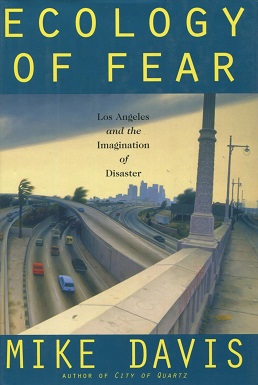Ecology of Fear facts for kids

First edition
|
|
| Author | Mike Davis |
|---|---|
| Country | United States |
| Language | English |
| Subject | History |
| Genre | Non-fiction |
| Publisher | Metropolitan Books |
|
Publication date
|
1998 |
| ISBN | 978-0375706073 |
Ecology of Fear: Los Angeles and the Imagination of Disaster is a book written in 1998 by Mike Davis. It looks at how the city of Los Angeles is shown in movies, TV shows, and news. The book explores how people imagine Los Angeles as a place full of dangers and big problems.
Contents
What is Ecology of Fear About?
This book dives into the idea that Los Angeles often seems like a city facing constant threats. These threats can be real, like earthquakes or wildfires. But they can also be imagined, like scary stories in movies.
Los Angeles: A City of Disasters?
Mike Davis explores how the media often focuses on disasters in Los Angeles. This includes natural events like earthquakes and floods. It also covers other challenges that make the city seem risky. The book suggests that this focus creates a certain "fear" about the city.
Real Dangers in Los Angeles
Los Angeles is known for certain natural events.
- Earthquakes: The city sits on active fault lines. This means earthquakes are a real and regular concern.
- Wildfires: Dry weather and strong winds can lead to large wildfires. These fires can cause a lot of damage.
- Floods: Heavy rains can sometimes cause flooding. This happens especially in areas near rivers or canyons.
How Media Shapes Our View
The book talks about how movies, TV shows, and news reports often highlight these dangers. This can make people think of Los Angeles as a very dangerous place. It shows how stories can make us imagine things in a certain way.
The "Imagination of Disaster"
The phrase "imagination of disaster" means how we picture big problems. It's not just about what actually happens. It's also about the stories we tell ourselves. These stories can be from books, movies, or even news headlines.
Why Does This Matter?
Mike Davis suggests that this "imagination of disaster" can affect the city. It can change how people feel about living there. It can also influence how the city plans for the future. The book makes us think about how we see cities. It asks if our views are based on facts or on exciting stories.

